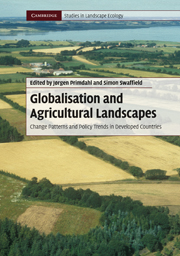Book contents
- Frontmatter
- Contents
- List of Contributors
- Preface
- 1 Globalisation and the sustainability of agricultural landscapes
- 2 Agricultural liberalisation, multifunctionality and the WTO: competing agendas for the future of farmed landscapes
- 3 Globalisation of agricultural landscapes: a land systems approach
- 4 Agricultural landscape changes through globalisation and biodiversity effects
- 5 Swiss agricultural policy reform: landscape changes in consequence of national agricultural policy and international competition pressure
- 6 Local landscape consequences of macro-scale policy reform: the New Zealand experiment
- 7 Rural landscape differentiation in the face of changing demands and policies: a typology of rural areas in Portugal
- 8 Globalisation and the local agricultural landscape: current change patterns and public policy interventions
- 9 From totalitarian to democratic landscapes: the transition in Estonia
- 10 Rural landscape change as a product of US federal policy
- 11 New approaches for urban–rural areas in Dutch spatial planning
- 12 Restoring agricultural landscapes in shrinking cities: re-inventing traditional concepts in Japanese planning
- 13 Globalisation and local agricultural landscapes: patterns of change, policy dilemmas and research questions
- Index
- References
11 - New approaches for urban–rural areas in Dutch spatial planning
Published online by Cambridge University Press: 05 June 2012
- Frontmatter
- Contents
- List of Contributors
- Preface
- 1 Globalisation and the sustainability of agricultural landscapes
- 2 Agricultural liberalisation, multifunctionality and the WTO: competing agendas for the future of farmed landscapes
- 3 Globalisation of agricultural landscapes: a land systems approach
- 4 Agricultural landscape changes through globalisation and biodiversity effects
- 5 Swiss agricultural policy reform: landscape changes in consequence of national agricultural policy and international competition pressure
- 6 Local landscape consequences of macro-scale policy reform: the New Zealand experiment
- 7 Rural landscape differentiation in the face of changing demands and policies: a typology of rural areas in Portugal
- 8 Globalisation and the local agricultural landscape: current change patterns and public policy interventions
- 9 From totalitarian to democratic landscapes: the transition in Estonia
- 10 Rural landscape change as a product of US federal policy
- 11 New approaches for urban–rural areas in Dutch spatial planning
- 12 Restoring agricultural landscapes in shrinking cities: re-inventing traditional concepts in Japanese planning
- 13 Globalisation and local agricultural landscapes: patterns of change, policy dilemmas and research questions
- Index
- References
Summary
Introduction
The Netherlands is a densely populated and highly urbanised delta area, about half of which is situated below sea-level. In 2007 16.4 million people lived on 41,528 km2. Its landscapes reflect an age-long struggle with land and water. Through reclamations, the Dutch have made their country fit for habitation and agricultural production over the ages. Regulation of the water level by technical means has resulted in a highly man-made landscape of ‘polders’, especially in the lower parts of the country. Without dykes and dunes a major part of the country would just not exist (Figure 11.1).
The Dutch word ‘polder’ reflects core characteristics of both the country and its people. In a narrow sense it refers to a spatial-technical category, i.e. a spatial entity in which the water level is regulated by technical means. As early as the Middle Ages the shared concerns of farmers and landowners about adequate management of land and water forced them to organise themselves into water boards and to coordinate their actions. And so, practices of consultation, negotiation and coordination between relevant actors became ‘normal Dutch practice’ quite early. Although Dutch society has grown much more complex today, its core identity is still in its ‘polder culture’. It is rooted in a historical understanding of mutual interdependencies between the inhabitants of the ‘polder’.
Taking this history into account, it is quite obvious that ‘spatial planning’ in terms of future-oriented, coordinated action regarding spatial development and physical layout is not a recent phenomenon.
- Type
- Chapter
- Information
- Globalisation and Agricultural LandscapesChange Patterns and Policy trends in Developed Countries, pp. 201 - 224Publisher: Cambridge University PressPrint publication year: 2010
References
- 1
- Cited by



